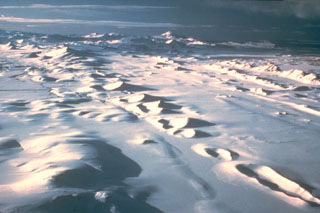Report on Bardarbunga (Iceland) — 10 September-16 September 2014
Smithsonian Institution / US Geological Survey
Weekly Volcanic Activity Report, 10 September-16 September 2014
Managing Editor: Sally Sennert.
Please cite this report as:
Global Volcanism Program, 2014. Report on Bardarbunga (Iceland) (Sennert, S, ed.). Weekly Volcanic Activity Report, 10 September-16 September 2014. Smithsonian Institution and US Geological Survey.
Bardarbunga
Iceland
64.633°N, 17.516°W; summit elev. 2000 m
All times are local (unless otherwise noted)
During 10-16 September, IMO maintained Aviation Colour Code Orange due to continued activity at Bárdarbunga’s Holuhraun eruptive fissure. Lava flows continued to advance at a consistent rate toward the E and W, and by 13 September, the lava field measured 24.5 km2. The main flow had entered the river bed of Jökulsá á Fjöllum and continued to follow its course; steam rose from the river where the lava was in contact but no explosive activity occurred. Persistent subsidence was detected from the Bárðarbunga caldera; approximately 23 m of total subsidence was measured during a survey on 14 September.
Seismicity persisted mainly around the caldera and the Dyngjujökull glacier. The largest earthquakes, M 5.5, M 5.3, and M 5.0, were detected on 10, 11, and 15 September respectively.
IMO reported continued elevated SO2 emissions during 10-16 September and issued warnings to the public in the municipality of Fjarðarbyggð on 13 September.
Geological Summary. The large central volcano of Bárðarbunga lies beneath the NW part of the Vatnajökull icecap, NW of Grímsvötn volcano, and contains a subglacial 700-m-deep caldera. Related fissure systems include the Veidivötn and Trollagigar fissures, which extend about 100 km SW to near Torfajökull volcano and 50 km NE to near Askja volcano, respectively. Voluminous fissure eruptions, including one at Thjorsarhraun, which produced the largest known Holocene lava flow on Earth with a volume of more than 21 km3, have occurred throughout the Holocene into historical time from the Veidivötn fissure system. The last major eruption of Veidivötn, in 1477, also produced a large tephra deposit. The subglacial Loki-Fögrufjöll volcanic system to the SW is also part of the Bárðarbunga volcanic system and contains two subglacial ridges extending from the largely subglacial Hamarinn central volcano; the Loki ridge trends to the NE and the Fögrufjöll ridge to the SW. Jökulhlaups (glacier-outburst floods) from eruptions at Bárðarbunga potentially affect drainages in all directions.

